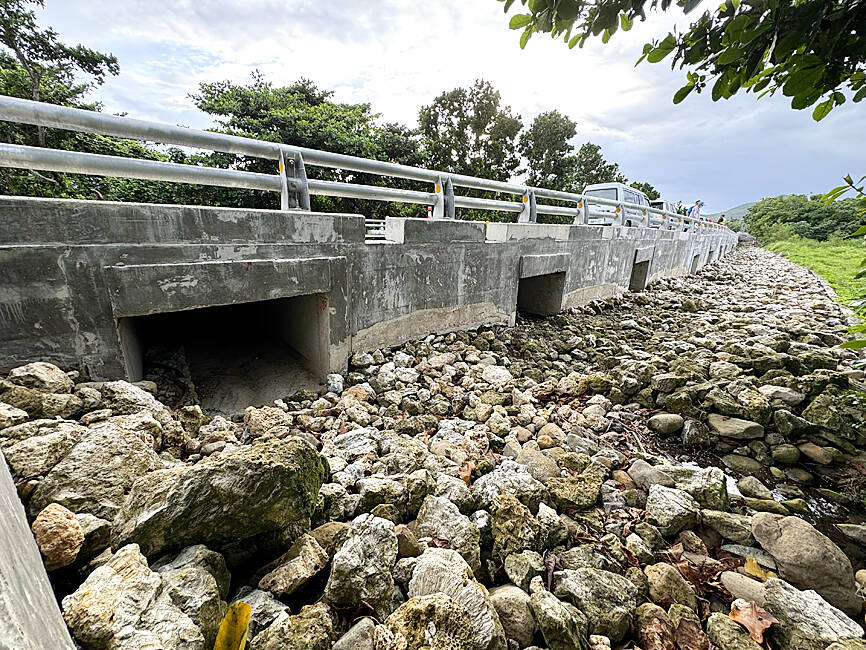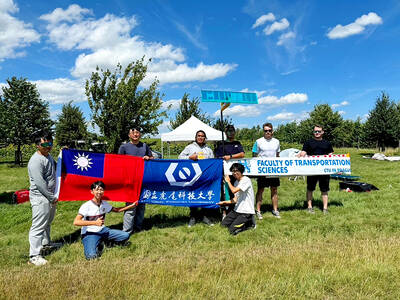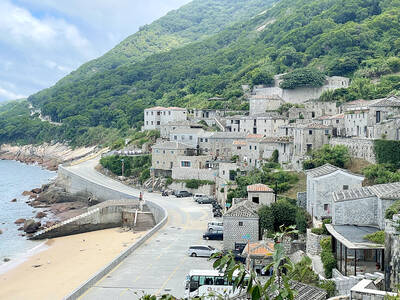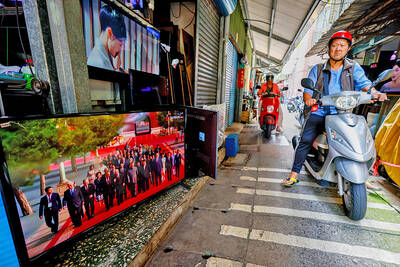The Highway Bureau yesterday said that wildlife crossings built along Highway 26 have helped reduce land crab deaths caused by vehicles by 81 percent, but experts said more needs to be done to protect the species.
Since 2008, the bureau has restricted access to the highway’s Banana Bay (香蕉灣) section on certain days of the year, given its proximity to the natural habitat of land crabs.
At one point 62 different land crabs were recorded in the area, accounting for 95 percent of the species found in Taiwan, studies showed.

Photo: Tsai Yun-jung, Taipei Times
Taiwan’s land crab population has declined 95 percent in the past 30 years due to urban expansion, invasive foreign species, excessive capturing by humans and their migratory routes during the spawning season being cut off by roads, the bureau said.
Although land crabs spend most of their lives on land, female land crabs must annually migrate to the sea to release their larvae. Land crabs living around Banana Bay must cross Highway 26 before reaching the sea.
A study conducted by Taiwan Academy of Ecology chairman Liu Hung-chang (劉烘昌) from June 2019 to Aug. 31, 2019, showed that as many as 240 land crabs could be killed within the Banana Bay section.
The bureau in 2008 launched efforts to protect land crabs by reducing the number of accessible traffic lanes in the section from 6:30pm to 8:30pm on certain days during the spawning season. In 2017, hemp ropes and wooden bars were installed in drainage culverts to help land crabs cross the highway.
Last year, the bureau further elevated the height of the highway and installed 36 more culverts that function as wildlife crossings. This year, the bureau placed coral stones and driftwood to guide land crabs to access the passages.
The additional culverts installed last year have proven to be effective, as they reduced the road mortality rate of land crabs in the section by 81 percent, the bureau’s South Region Branch Office Director Chen Kuei-fang (陳貴芳) said.
The bureau was set to control traffic at the Banana Bay section in three time periods, including from 6:30pm to 8:30pm from July 20 to 22 and Sunday to today, as well as from 6pm to 8pm from Sept. 17 to 19.
During the traffic control periods, the accessible traffic lanes at the Banana Bay section would be reduced to two from four. The lanes would be opened for 10 minutes for every 10 minutes they are closed, the bureau said.
Volunteers would use the time to study and record the number of land crabs crossing the section and bring them to the seashore, the bureau said.
On Sunday, volunteers used captured female crabs to show how they walk to sea to release larvae.
Liu told reporters in a presentation on the site that wildlife crossings cannot completely protect land crabs from being killed by drivers.
“The fundamental issue is that land crabs live in spring zones behind the residential area. They are pretty stubborn and would insist on going in the direction that they believe would lead them to the sea,” he said.
“When it is time to release larvae, they are more likely to migrate through routes near the residential area. Our wildlife crossings are not always in the proximity of residential areas. As such, most of the land crabs still migrate at routes north of culverts. More needs to be done to protect them,” Liu said.

The Chinese military has built landing bridge ships designed to expand its amphibious options for a potential assault on Taiwan, but their combat effectiveness is limited due to their high vulnerability, a defense expert said in an analysis published on Monday. Shen Ming-shih (沈明室), a research fellow at the Institute for National Defense and Security Research, said that the deployment of such vessels as part of the Chinese People’s Liberation Army (PLA) Navy’s East Sea Fleet signals a strong focus on Taiwan. However, the ships are highly vulnerable to precision strikes, which means they could be destroyed before they achieve their intended

The Taiwan Experience Education Program (TEEP) has funded short-term internships in Taiwan for more than 4,500 young people from more than 40 countries since 2015, with the goal of attracting and retaining international talent, the Ministry of Education said yesterday. Fifty-five colleges launched 514 projects this year, including in fields such as semiconductors, artificial intelligence, medicine and biotechnology, green energy, and sustainability, it said. The program provides research and practical internships in Taiwan for two to six months, and offers cultural exchange and networking opportunities, the ministry said. For example, National Formosa University’s Embedded System and Autopilot Laboratory developed two solar-powered drones in

GLOBAL: Although Matsu has limited capacity for large numbers of domestic tourists, it would be a great high-end destination for international travelers, an official said Lienchiang County’s (Matsu) unique landscape and Cold War history give it great potential to be marketed as a destination for international travelers, Tourism Administration Director General Chen Yu-hsiu (陳玉秀) said at the weekend. Tourism officials traveled to the outlying island for the Matsu Biennial, an art festival that started on Friday to celebrate Matsu’s culture, history and landscape. Travelers to Matsu, which lies about 190km northwest of Taipei, must fly or take the state-run New Taima passenger ship. However, flights are often canceled during fog season from April to June. Chen spoke about her vision to promote Matsu as a tourist attraction in

Taipei resident Mu Chu-hua caught some glimpses of China’s mighty military parade on YouTube on Wednesday. As she watched hypersonic missiles roll down Beijing’s Changan Avenue and troops march in lockstep, she did not feel like they posed a threat to Taiwan. Mu, a 69-year-old retiree, said she saw the parade as simply a way for Chinese President Xi Jinping (習近平) to “say thank you to the troops.” “I thought it was quite normal,” she said. “It was very cool.” China’s military parade commemorating the end of World War II was being watched internationally for insights into Beijing’s military advances and its show